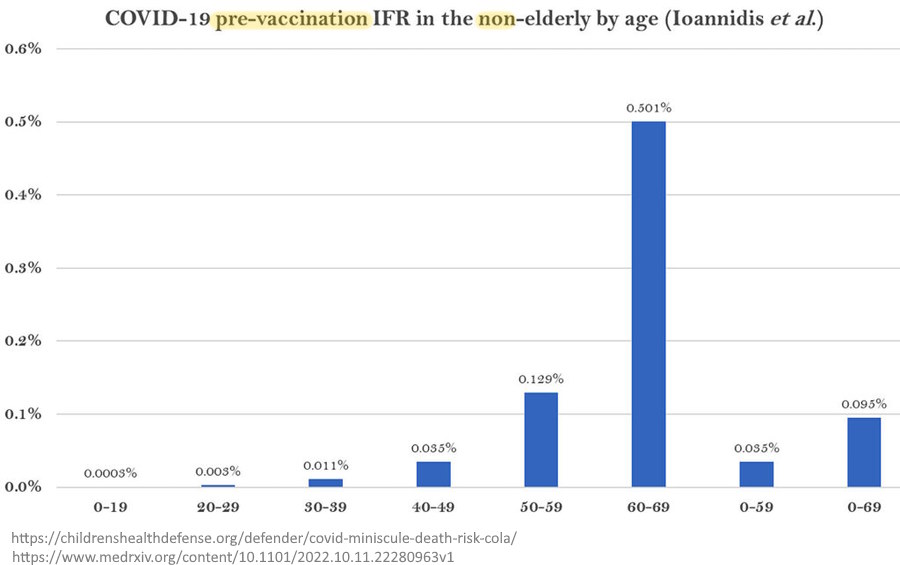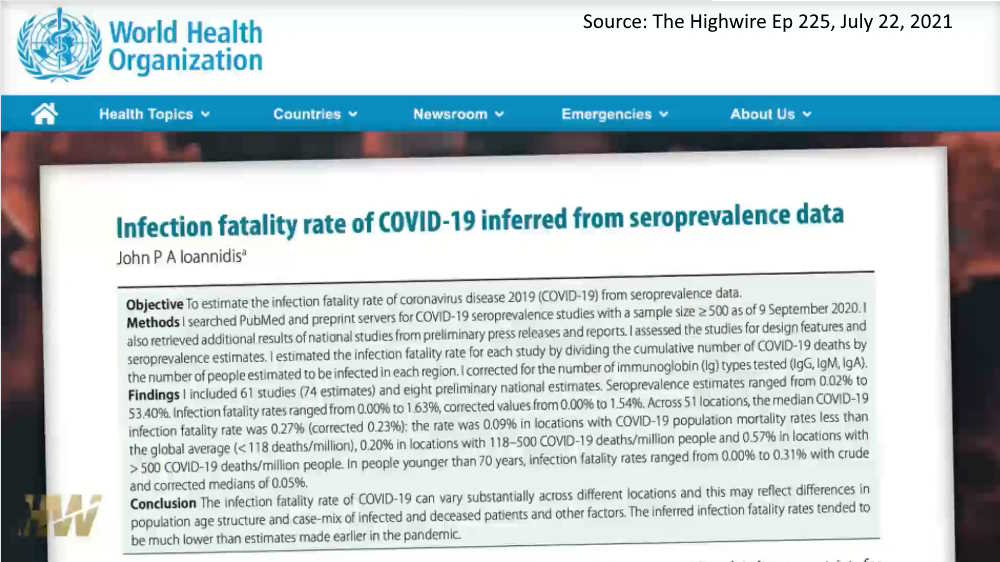John P. A. Ioannidis is the Professor of Medicine, of Epidemiology and Population Health, and of Statistics and of Biomedical Data Science from Stanford University. He is considered one of the world’s most cited and respected scientist. He has made contributions to evidence-based medicine, epidemiology, and clinical research. [1, 3]
Officially he is the C. F. Rehnborg Professor in Disease Prevention in the School of Medicine and Professor of Health Research and Policy (Epidemiology) and (by courtesy) of Statistic.
- Ioannidis has an extensive bio – HERE
- Ioannidis has authored some of the most cited publications in history – HERE, CREDIT
In August 2005 he published “Why Most Published Research Findings Are False” an essay which “is considered foundational to the field of meta-science.” We are told to “follow the science”, yet according to Prof. Ioannidis’ work, more than 90% of medical science is flawed – it can’t be replicated. What about the science behind mandated medicine?
From listening to Prof. Ioannidis’ personal journey he was probably an above average child: writing books at age 5 and doing complex mathematical equations by 8 years. Clearly he was a thinker, but also a kind soul John felt medicine would be the “best way to help people”.
In 2010 it was stated in The Atlantic that “Ioannidis may be one of the most influential scientists alive“. Ten years later the COVID-19 pandemic hit, and his scientific analysis of the emerging data did not fit ‘the narrative’ and he was “attacked”.
I underestimated how much power politics and media and powers outside of science could have on science. I think that I had no clue and no preparation for this invasion of science.
Prof John Ioannidis
By April 17, 2020 Prof. Ioannidis et al published a paper where they look at how much of the population had already developed antibodies against SARS-CoV-2, in other words who had already been infected with the virus. The data revealed that infections were 50-85 times higher than the confirmed cases, which in turn means the infection fatality rate (IFR), the probability of dying if you are infected, was “in the same ballpark as seasonal influenza” and not the alarming 3.4% which the WHO published!
On October 14, 2020 the Bulletin of the World Health Organisation published Professor Ioannidis’ paper looking at the infection fatality rate (IFR) for COVID-19 based on how many people already had antibodies to SARS-CoV-2 (seroprevalence data) which revealed that the median COVID-19 IFR was 0.27% – “much lower than estimates made earlier in the pandemic” of 3.4% –TIMELINE
Explore Dr Ioannidis data points in reverse chronological order
For ease of scanning, Peer Reviewed pandemic related papers are highlighted in red below, this is but a small collection of Prof. Ioannidis’ publications – but they tell a story.
2023
February 5, 2023 – Independent Truths with Dr. Scott Atlas Ep 3: John Ioannidis Interview: How Experts Got the Pandemic Science Wrong from the Beginning – WATCH
January 1, 2023 – Environmental Research: Age-stratified infection fatality rate of COVID-19 in the non-elderly population – Pezzullo and Ioannidis et al – READ [Preprint Oct 13, 2022], Brownstone Institute – ARTICLE, Dr Malone Substack – READ, Aaron Siri – TWEET
- “The largest burden of COVID-19 is carried by the elderly, and persons living in nursing homes are particularly vulnerable. However, 94% of the global population is younger than 70 years and 86% is younger than 60 years. The objective of this study was to accurately estimate the infection fatality rate (IFR) of COVID-19 among non-elderly people in the absence of vaccination or prior infection.”
- “Across 31 systematically identified national seroprevalence studies in the pre-vaccination era, the median infection fatality rate of COVID-19 was estimated to be 0.034% for people aged 0–59 years people and 0.095% for those aged 0–69 years.” –
- i.e. Under 70s less than 1% fatality rate – thus fast tracking vaccines and skipping safety testing is not justified – REF
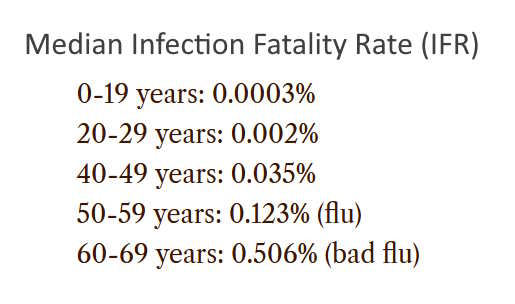
2022
November 2, 2022 – CHD | The Defender: Risk of Dying From COVID Always Was ‘Miniscule,’ Regardless of Age- Based on a new preprint analysis [Oct 13, 2022] by professor John Ioannidis – READ
- Pre-jab Infection Fatality Rate (IFR): for 19 years or younger, your risk of dying of COVID-19 was 0.0003%, or only 3 per 1 million infected
- Aged 60 to 69 – IFR was 0.501% or 1 out of 200 infected died
- Emerging evidence jabs causing immune dysfunction thus raising risk of dying from SARS-CoV-2 infection, even with the now-milder strains
October 19, 2022 – Schutz Film: Out to See – Documentary featuring Professor John Ioannidis – WATCH, READ
October 18, 2022 – The New Normal Substack | Michael Senger: New Study from Ioannidis: Covid’s IFR in 2020 Was Less Than 0.1% for Those Under 70, Even Lower Than Previously Believed – READ
October 17, 2022 – Daily Sceptic: COVID-19 Much Less Deadly Than Previously Thought, Major Study Finds (incl. graphs) – READ, Dr Alexander Substack – READ, CHD – READ
- Concluding AGAIN what was found in July 2020 [it’s the flu!, protect the elderly and get on with it]
October 13, 2022 – MedRxiv pre-print: Age-stratified infection fatality rate of COVID-19 in the non-elderly informed from pre-vaccination national seroprevalence studies – Pezzullo, Ioannidis et al – (version 1) – READ, Published Jan 1, 2023 – READ
- “The infection fatality rate (IFR) of COVID-19 among non-elderly people in the absence of vaccination or prior infection. Identified 40 eligible national seroprevalence studies covering 38 countries with pre-vaccination seroprevalence data
Meta-regression analyses suggested global IFR of:
- 0.03% for 0-59 years old (86% global population)
- 0.07% for 0-69 years old (94% global population)
- The current analysis suggests a much lower pre-vaccination IFR in non-elderly populations than previously suggested.
- Large differences did exist between countries and may reflect differences in comorbidities and other factors [country treatment protocols, vax mandates, immune nutrition etc]
July 28, 2022 – Vinay Prasad | Sensible Medicine Substack: John Ioannidis: How does Prof Ioannidis take stock of where we are? The Pandemic as of July 28, 2022 – an interview – TRANSCRIPT
March 20, 2022 – European J. of Epidemiology: Infection fatality rate of COVID-19 in community-dwelling elderly populations by Zxfors & Ioannidis – READ (Submitted July 13, 2021 – READ)
2021
December 10, 2021 – Vinay Prasad : John Ioannidis – Where are we now with COVID19? – WATCH
July 28, 2021 – European Jouornal of Epidemiology: Over- and under-estimation of COVID-19 deaths – John Ioannidis – READ, Covid deaths massively overcounted – ARTICLE
- “Death attribution in a syndemic like COVID-19 needs great caution.”
July 26, 2021 – Lecture hosted by Prof. Dr. Manuel Schabus, University of Salzburg – Prof. John P.A. Ioannidis talk on “COVID-19 epidemiology: risks, measures, and ending the pandemic” lecture – WATCH,
- Ivor Cummis edited version – Covid Realities from Stanford – WATCH
July 22, 2021 – The Highwire Ep 225 | The Jaxen Report: THE COVID BLAME GAME – @34min WATCH – Re October 14, 2020 study published in Bulletin of WHO – PDF
- Seroprevalence tests for antibodies to the SARS-CoV-2 virus. Antibody prevalence shows how many people have been infected. This is different to the PCR test which tests for the presence of the virus.
- Ioannidis “corrected for the number of immunoglobin (Ig) types tested (IgG, IgM, IgA)” and concluded the infection fatality rate (IFR) is between 0.05% to 0.23% (see below)
July 13, 2021 – Pre Print: Infection fatality rate of COVID-19 in community-dwelling elderly populations by Axfors & Ioannidis – READ
- Peer review published March 20, 2022 in European J of Epidemiology: Infection fatality rate of COVID-19 in community-dwelling elderly populations – READ
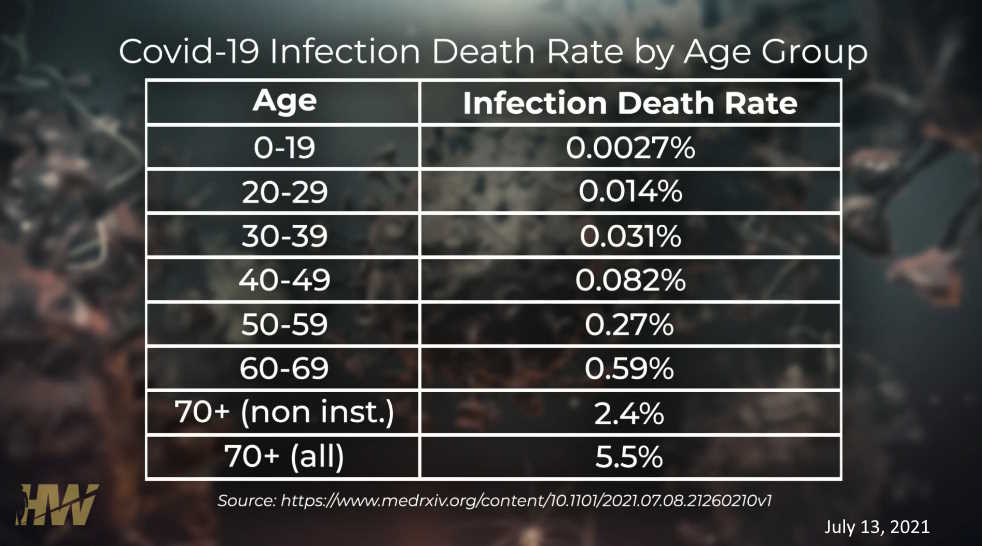
July, 2021 – Bulletin of the World Health Organization Volume 99, Number 7, July 2021, 477-540: Infection fatality rate of COVID-19 inferred from seroprevalence data – READ, PDF, ARCHIVE, The Highwire Get Factsinated – WATCH
- “Across 51 locations, the median COVID-19 infection fatality rate was 0.27% (corrected 0.23%)…In people younger than 70 years, infection fatality rates ranged from 0.00% to 0.31% with crude and corrected medians of 0.05%.“
- “Acknowledging these limitations, based on the currently available data, one may project that over half a billion people have been infected as of 12 September 2020, far more than the approximately 29 million documented laboratory-confirmed cases.” [The denominator likely 500,000,000, not 29,000,000]
April 2021 – Environmental Research: Second versus first wave of COVID-19 deaths: Shifts in age distribution and in nursing home fatalities – Ioannidis et al – READ
- Age distribution of COVID-19 deaths was fairly similar in the second vs first wave
- COVID-19 deaths in people <50 were uncommon and became more rare in the second wave
February 22, 2021 – International J. of Epidemiology: COVID-19 antibody seroprevalence in Santa Clara County, California by Bendavid, Gupta,Ioannedis, Bhattacharya et al – READ, Preprint April 17, 2020 – HERE
- Measuring the seroprevalence of antibodies to …[SARS-CoV-2] is central to understanding infection risk and fatality rates [IFR].
February 10, 2021 – Vinay Prasad | Plenary Session: Ep 341 Building a Meta-Research Career and Constructing COVID-19 Health Policy with Dr. John Ioannidis – LISTEN, LISTEN2
- A “deep dive into his work from 2000 all the way up to present day: his career from 2000 to 2010, his move to Stanford, and his work on COVID-19. We take a deep dive into his work on COVID-19: IFR, shielding ratio, the question of whether lockdown works, opening schools, and what public health policy should be.”
January 5, 2021 – European Journal of Clinical Investigation: Assessing mandatory stay-at-home and business closure effects on the spread of COVID-19 – by Bendavid, Oh, Bhattacharya & Ioannidis – READ
2020
November 30, 2020 – Scientific American: The Ioannidis Affair: A Tale of Major Scientific Overreaction – Data, not guesswork, is what should guide public health decisions – Ioannidis suggested since March 2020 – READ
October 14, 2020 – Bulletin of the World Health Organisation – 2021;99:19–33F: The infection fatality rate of COVID-19 inferred from seroprevalence data by Ioannidis – PDF, ARCHIVE, [doi: http://dx.doi.org/10.2471/BLT.20.265892] (submitted to WHO May 13, 2020) – PDF, ARCHIVE, READ, BJM – READ,
- This study “concluded that among people <70 years old across the world, infection fatality rates ranged from 0.00% to 0.57% with a median of 0.05% [Equivalent to Annual Flu] across the different global locations” Dr Paul Alexander – REF
- Ioannidis’ paper showed “an infection fatality rate (IFR) for Covid of 0.00-0.57% (0.05% for under 70s), far lower than originally feared and no different to severe flu. The paper is published on WHO’s own Bulletin but ignored by UK mainstream media. – BMJ – REF
- Dr Mike Yeadon on The Highwire – EXCERPT “It’s not worse than bad seasonal influenza”
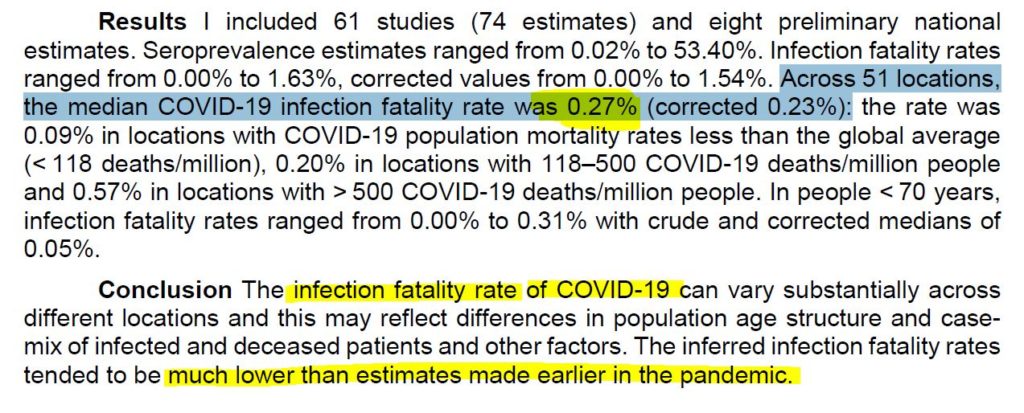
October 3, 2020 – Vinay Prasad: 3.14 COVID-19 with Dr. John Ioannidis & Trial Eligibility with Dr. Mary-Elizabeth Percival – WATCH
- A 2-hour-long, far-ranging interview with Dr. John Ioannidis of Stanford University on, broadly, meta-research and COVID-19 – including his recent controversies.
September, 2020 – Environmental Research – Population-level COVID-19 mortality risk for non-elderly individuals overall and for non-elderly individuals without underlying diseases in pandemic epicenters – Ioannidis et al – READ
July 27, 2020 – Alpha News: Commentary: John Ioannidis was right about COVID-19 being a ‘once-in-a-century’ data fiasco – The unreliability of COVID-19 data is a problem everyone seems to agree on – READ
July 26, 2020 – The Highwire | Jefferey Jaxen: TRUTH OVER FEAR: FRAMING AMERICA’S SECOND COVID ‘SPIKE’ – READ
- Dr Ioannidis concluded “People <65 years old have very small risks of COVID-19 death even in the hotbeds of the pandemic and deaths for people <65 years without underlying predisposing conditions are remarkably uncommon.” Suggesting ” strategies should focus on protecting high-risk elderly individuals. His data-driven, scientifically supported calls were ignored. Despite this dire warning, multiple states, like Governor Andrew Cuomo’s New York, packed nursing homes with COVID-positive patients, decimating a generation of elderly Americans.”
July 25, 2020 – Buzz Feed: An Elite Group Of Scientists Tried To Warn Trump Against Lockdowns In March – READ
- “John Ioannidis’s controversial studies claim that the coronavirus isn’t that big a threat. Before the Stanford scientist did any of them, he wanted to take that message to the White House.”
July 2, 2020 – FEE Stories: Modelers Were ‘Astronomically Wrong’ in COVID-19 Predictions, Says Leading Epidemiologist—and the World Is Paying the Price – Dr. John Ioannidis had a harsh assessment of modelers who predicted as many as 40 million people would die and the US healthcare system would be overrun because of COVID-19 – READ, re Greek Reporter interview
June 27, 2020 – Greek Reporter: Up to 300 Million People May Be Infected by Covid-19, Stanford Guru John Ioannidis Says – TRANSCRIPT
June 16, 2020 – CNN: Making sense of emerging Coronavirus data – re Santa Clara study on seroprevalence – WATCH,
- FEE stories: World-Leading Infectious Disease Expert Explains Why Government Lockdowns Should End – READ
- Intellectual Take Out: Infectious Disease Expert Calls for End to Lockdowns – READ
June 15, 2020 – GLP: Viewpoint: Stanford epidemiologist John Ioannidis’ COVID-19 controversy illustrates the politicization of science – READ
June 11, 2020 – UnDark | Opinion: John Ioannidis and Medical Tribalism in the Era of Covid-19 – The attacks on Ioannidis from the medical community and the popular press …tingled with partisanship – READ
June 11, 2020 – International Institute of Forecassters | invited Opinion: Forecasting for COVID-19 has failed by Ioannidis et al – PDF, Forecasters: COVID-19: Ioannidis vs Taleb – SOURCE
- “Epidemic forecasting has a dubious track-record, and its failures became more prominent with COVID-19. Poor data input, wrong modeling assumptions, high sensitivity of estimates, lack of incorporation of epidemiological features, poor past evidence on effects of available interventions, lack of transparency, errors, lack of determinacy, looking at only one or a few dimensions of the problem at hand, lack of expertise in crucial disciplines, groupthink and bandwagon effects and selective reporting are some of the causes of these failures.” – REF
May 26, 2020 – Boston Review: The Totality of the Evidence – As policymakers debate the right response to COVID-19, they must take seriously the harms of pandemic policies, not just their benefits by John Ioannidis – READ
May 19, 2020 – MedRxiv preprint: The infection fatality rate of COVID-19 inferred from seroprevalence data by Ioannidis (Version 1) – READ, Revisions: June 8, 2020 – Ver2, Jul 14, 2020 – Ver3, NOW peer review published October 14, 2020 in Bulletin of the World Health Organisation – READ, PDF (also see above)
- Concluding: Estimates of infection fatality rates inferred from seroprevalence studies tend to be much lower than original speculations made in the early days of the pandemic.
- This study “concluded that among people <70 years old across the world, infection fatality rates ranged from 0.00% to 0.57% with a median of 0.05% [Equivalent to Annual Flu] across the different global locations” Dr Paul Alexander – REF, refering to version 2 of pre-print
May 16, 2020 – Buzz Feed: JetBlue’s Founder Helped Fund A Stanford Study That Said The Coronavirus Wasn’t That Deadly – A Stanford whistleblower complaint alleges that the controversial John Ioannidis study failed to disclose important financial ties and ignored scientists’ concerns that their antibody test was inaccurate. – READ
May 13, 2020 – Dr Ioannidis submitted paper to WHO Bulletin – PDF, MedRxiv May 19, 2020 (see above) Published Oct 14, 2020 – PDF, The Highwire Get Factsinated – WATCH
- “The infection fatality rate of COVID-19 can vary substantially across different locations …[and] tended to be much lower than estimates made earlier in the pandemic.”
May 11, 2020 – MedRxiv pre print: Evaluation of Clinical Trial Data Sharing Policy in Leading Medical Journals – Danchev, Ioannidis et al (Version 1) – READ
- Lack of transparency in data sharing for trials published in JAMA, Lancet, and NEJM – “a wide gap between declared and actual data sharing exists”
May 9, 2020 – UnDark: The Undark Interview: John Ioannidis Responds to His Critics – on his controversial antibody study and participation in partisan media – READ
May 6, 2020 – Homeland Security & Governmental Affairs: Roundtable – COVID-19: How New Information Should Drive Policy – ARCHIVE, ORIGINAL, Included testimony from Dr Scott Atlas, Dr Pierre Kory and Prof. John Ioannidis etc.
May 5, 2020 – MedRxiv preprint – Population-level COVID-19 mortality risk for non-elderly individuals overall and for non-elderly individuals without underlying diseases in pandemic epicentres – Ioannidis et al – READ, Published Sept 2020 in Environmental Research – READ
- “People <65 years old have very small risks of COVID-19 death even in pandemic epicentres and deaths for people <65 years without underlying predisposing conditions are remarkably uncommon. Strategies focusing specifically on protecting high-risk elderly individuals should be considered in managing the pandemic.”
- “Focused” measures is what the Great Barrington Declaration recommended Oct 4, 2020, shortly after peer review publication of this paper – TIMELINE
April 19, 2020 – American Institute of Economic Research: Who Is John Ioannidis? – READ
April 17, 2020 – The Press & The Public Project an Interview by John Kirby |Journeyman Pictures: Dr John Ioannidis Announces Results of COVID 19 Serology Study in Santa Clara, California – WATCH, FULL
“Our Santa Clara seroprevalence study is now out. It shows 50-85 times underestimated number of infections, therefore 50-85 times overestimated infection rate fatality. True infection rate fatality is in the ballpark of seasonal influenza.“
Prof. John Ioannidis
April 17, 2020 – MedRxiv pre print: COVID-19 Antibody Seroprevalence in Santa Clara County, California – Bendavid, Gupta, Ioannedis, Bhattacharya et al (Version 1) – READ, Apr 30, 2020 Ver2, Peer reviewed Feb 22, 2021 International J. of Epidemiology – HERE, Interview with Prof. John Ioannidis – WATCH
- Conclusion: “The population prevalence of SARS-CoV-2 antibodies in Santa Clara County implies that the infection is much more widespread than indicated by the number of confirmed cases. Population prevalence estimates can now be used to calibrate epidemic and mortality projections”
April 17, 2020 – Journeyman Pictures | Perspectives on the Pandemic – Episode 4: Dr. John Ioannidis an Update – WATCH, EXCERPT, Time to Start Opening Up, with Science, not Partisan Politics – EXCERPT, FEE stories – ARTICLE
April 8, 2020 – MedRxiv: Population-level COVID-19 mortality risk for non-elderly individuals overall and for non-elderly individuals without underlying diseases in pandemic epicenters – Ioannedis et al (Version 1) – READ, Published Sept 2020 in Environmental Research – HERE
March 23, 2020 – Journeyman Pictures | Perspectives on the Pandemic – Episode : Dr John Ioannidis of Stanford University – WATCH
March 19, 2020 – CBC: Prominent scientist dares to ask: Has the COVID-19 response gone too far? – an epic battle between two famous scientists over the world’s response to the COVID-19 pandemic – Stanford University epidemiologist John Ioannidis versus Harvard epidemiologist Marc Lipsitch – READ
- “The debate comes down to questions about data. What is the true fatality rate of COVID-19? How many people are already infected?”
March 19, 2020 – European Journal of Clinical Investigation | Editorial: Coronavirus disease 2019: The harms of exaggerated information and non-evidence-based measures by Ioannidis – READ
- “The [current pandemic] challenge is compounded, however, by exaggerated information. This can lead to inappropriate actions/ It is important to differentiate promptly the true epidemic from an epidemic of false claims and potentially harmful actions”
March 17, 2020 – Stat News | First Opinion: A fiasco in the making? As the coronavirus pandemic takes hold, we are making decisions without reliable data – by John P.A. Ioannidis – READ, CREDIT & CREDIT
- “The current coronavirus disease, Covid-19, has been called a once-in-a-century pandemic. But it may also be a once-in-a-century evidence fiasco.”
- “…we lack reliable evidence on how many people have been infected with SARS-CoV-2 or who continue to become infected. Better information is needed to guide decisions and actions of monumental significance and to monitor their impact.”
- Reported case fatality rates, like the official 3.4% rate from the World Health Organization, cause horror — and are meaningless”
- The closed population of the Diamond Princess cruise ship, testing revealed a case fatality rate (CFR) of 1.0%, in a largely elderly population..plus “extra sources of uncertainty” – 7 deaths among 700 infected passengers and crew.
- “…the real death rate could stretch from five times lower (0.025%) to five times higher (0.625%).”…”reasonable estimates for the case fatality ratio in the general U.S. population vary from 0.05% to 1%.”…”A population-wide case fatality rate of 0.05% is lower than seasonal influenza“
- “…even some so-called mild or common-cold-type coronaviruses that have been known for decades can have case fatality rates as high as 8% when they infect elderly people in nursing homes.”
2017
September 7, 2017 – European Journal of Clinical Investigation: How to survive the medical misinformation mess – Ioannidis et al – READ, CREDIT
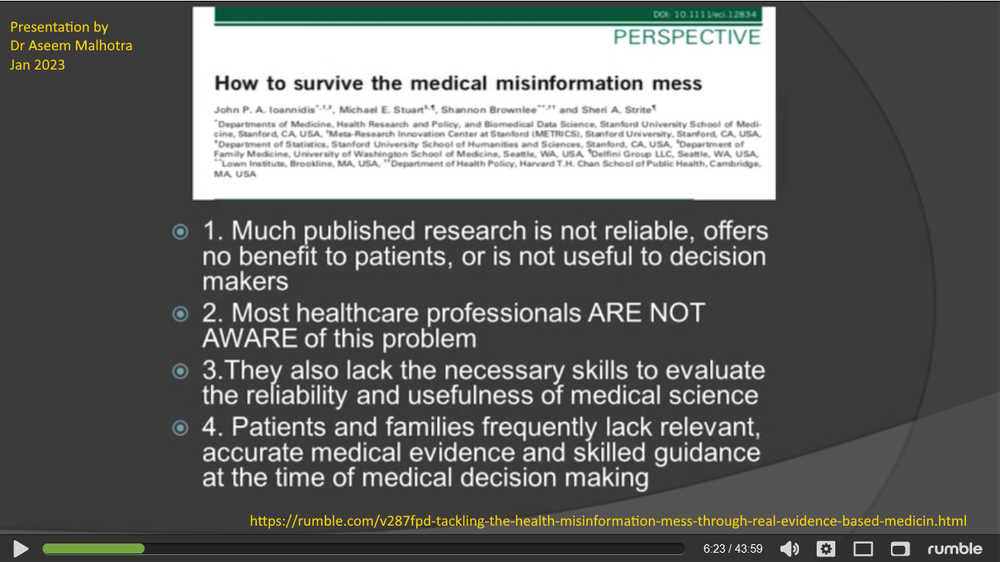
2010
November 2010 – The Atlantic: Lies, Damned Lies, and Medical Science by Freedman – READ, CREDIT
- Ioannidis is “what’s known as a meta-researcher, and he’s become one of the world’s foremost experts on the credibility of medical research”
- He charges that as much as 90% of published medical literature that doctors rely on is flawed!, and yet they still draw upon this misinformation in their everyday practice
- Dr John Ioannidis has spent his career challenging his peers by exposing their bad science
- “His work has been widely accepted by the medical community; it has been published in the field’s top journals, where it is heavily cited; and he is a big draw at conferences”
- “Ioannidis may be one of the most influential scientists alive. Yet for all his influence, he worries that the field of medical research is so pervasively flawed, and so riddled with conflicts of interest, that it might be chronically resistant to change—or even to publicly admitting that there’s a problem.”
2005
August 30, 2005 – PLoS Medicine: Why Most Published Research Findings Are False by John Ioannidis – READ
- John Ioannidis had taken a careful look at the reproducibility of findings only to discover that most fail. – REF
2001
Jauary 2001 – JAMA: Completeness of safety reporting in randomized trials: an evaluation of 7 medical areas – Ioannidis et al – READ
- Conclusion: “The quality and quantity of safety reporting vary across medical areas, study designs, and settings but they are largely inadequate. Current standards for safety reporting in randomized trials should be revised to address this inadequacy.”

